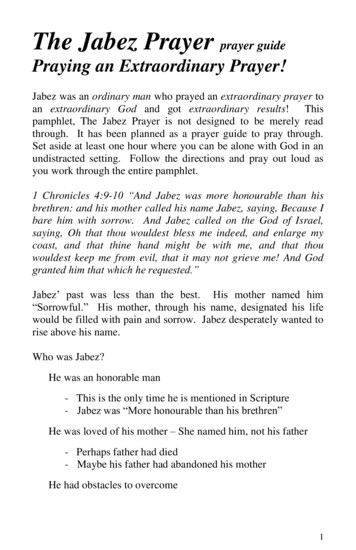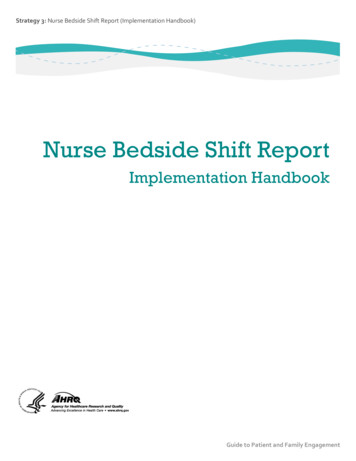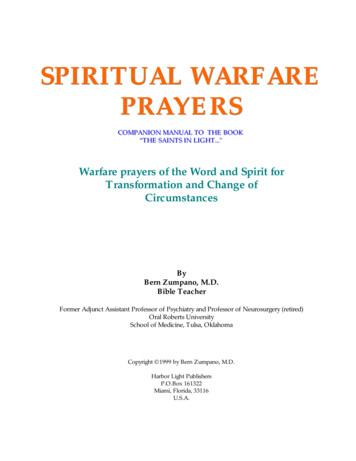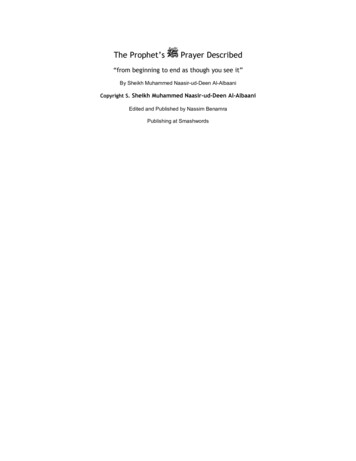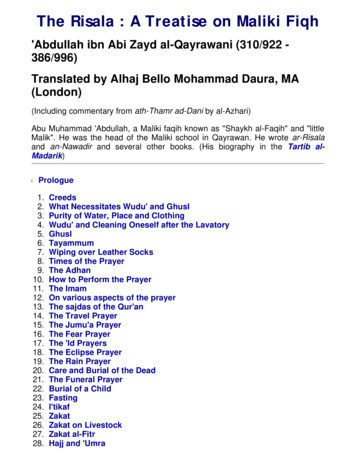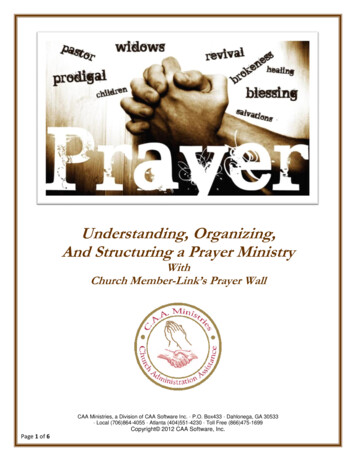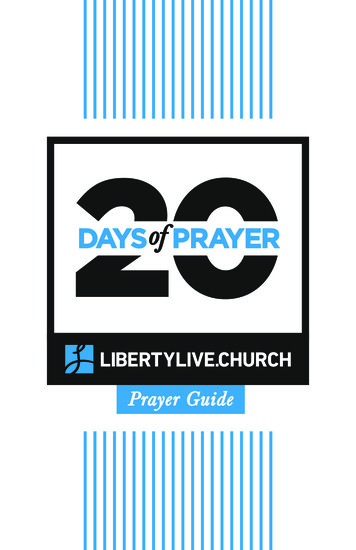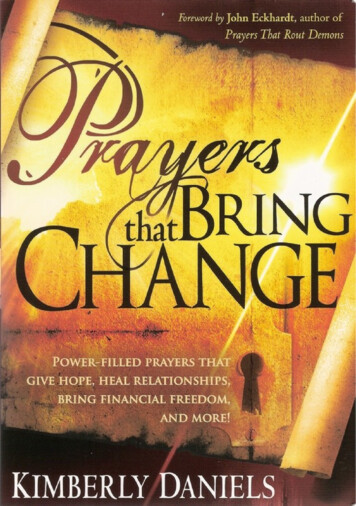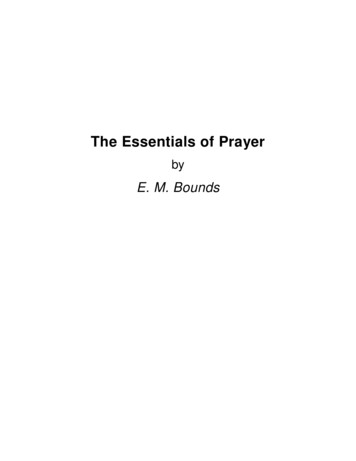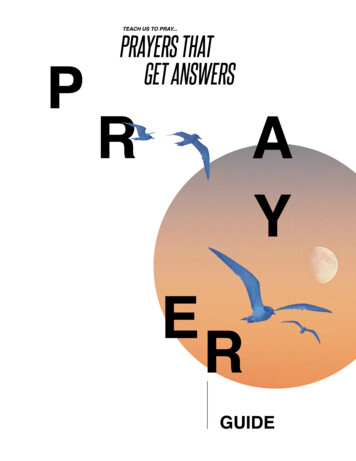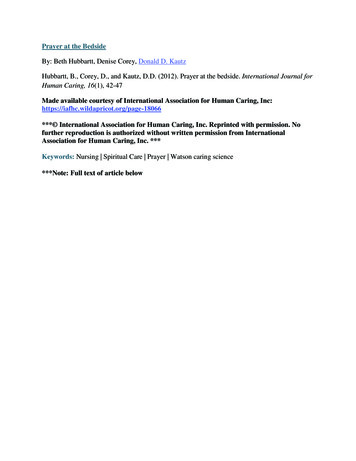
Transcription
Prayer at the BedsideBy: Beth Hubbartt, Denise Corey, Donald D. KautzHubbartt, B., Corey, D., and Kautz, D.D. (2012). Prayer at the bedside. International Journal forHuman Caring, 16(1), 42-47Made available courtesy of International Association for Human Caring, Inc:https://iafhc.wildapricot.org/page-18066*** International Association for Human Caring, Inc. Reprinted with permission. Nofurther reproduction is authorized without written permission from InternationalAssociation for Human Caring, Inc. ***Keywords: Nursing Spiritual Care Prayer Watson caring science***Note: Full text of article below
Prayer at the BedsideBeth Hubbartt, RN, MSN, CRRN and Denise Corey, RN, BSN, CRRNWake Forest University Baptist Medical CenterDonald D. Kautz, RN, PhD, CNRN, CRRNUniversity of North Carolina at Greensboroabstractthis article is designed to assist nurses in providing prayer to patients from all faithtraditions. Included are guidelines for conducting an assessment to determine thepatient’s prayer preferences, strategies for overcoming barriers to prayer, resources forfinding suitable prayers for healing, and some short, practical prayers for nurses andpatients. Praying with patients is one way for nurses to honor a patient’s spirit throughWatson’s caring science. the goal is to assist nurses to include prayer in their practicefor patients who desire prayer.Key Words: Prayer, praying with patients,nurses praying with patients, Watson caringscienceIntroductionSpiritual care has long been recognizedas essential in providing holistic care topatients. Rieg, Mason, and Preston (2006)noted that most nurses recognize spiritualcare as an essential component of care.Spiritual care is a component of mental andsocial health, and nursing involves healingthe body, mind, and spirit and is an integralpiece of providing compassionate healthcarefor those from all cultures. Spiritual careremains one of the oldest methods ofalleviating suffering and promoting healing.Encouraging nurses to provide spiritual careis not new. Florence Nightingale regularlyaddressed the spiritual needs of her patientsand believed that prayer “is the process oflinking the outward personal self with theinward divine spirit” (Macrae, 2001, p. 93).The Joint Commission (TJC) (2008) andthe American Nurses Credentialing Center(ANCC) (2008), which provides Magnetcertification, both encouraged nurses tomeet the spiritual needs of patients. Boththe American Nurses Association (ANA)Code of Ethics (2005) and the InternationalCouncil of Nurses Code of Ethics (2006)encouraged nurses to provide spiritual care,including prayer if the patient so desires.The professional expectation to meet42spiritual needs, including praying withpatients and families, is also reflected instandardized nursing languages, includingNursing Diagnosis (NANDA International,2008), Nursing Intervention Classifications(NIC) (Bulechek, Butcher, & Dochterman,2008), and Nursing Outcome Classifications(NOC) (Moorhead, Johnson, Maas, & Swan,2008) (commonly referred to as NNNlanguage). (Johnson et al, 2006). Delegato(2007) argued that nurses have aresponsibility to engage in activities thatare restorative in all three areas - body,mind, and spirit. She argued that nursescan improve spiritual care outcomes bysupporting and facilitating the patientand family’s need for prayer. French andNarayanasamy (2011) pointed out thatseveral studies suggested a correlationbetween prayer and health, and thatthroughout the world our patients havebecome more interested than ever inspiritual issues as a part of their healthcare.Unfortunately, staff may not recognize theimportance of prayer for some patients orrealize that some patients desire prayers.Staff may also feel ethical dilemmas aboutpraying with patients and may not knowhow to pray with them. This articledescribes how prayer can fit into nursingpractice, provides strategies to overcomebarriers to prayer, and includes some short,practical prayers for nurses and patients.International Journal for Human CaringHow Prayer fits into nursing PracticeThere are several ways that nurses canprovide spiritual care. One is through prayerwith patients at the bedside. Nurses canbuild trust by becoming aware of andrespecting patients’ beliefs, religiouspractices, and prayer preferences. All ofthese practices, however, must focus on thepatient’s usual practices and be led by thepatient, to avoid coercion. Some nursesbelieve it is against their own values to praywith patients. Some believe it is wrong andunethical (French & Narayanasamy, 2011)to pray with a patient of a different faith.Some have no belief in the power of prayeror are agnostic or atheist. Nurses can choosenot to pray with patients and refer patientswho request prayers to another nurse. Thisarticle is designed to assist nurses who areopen to the idea of praying with patientsand want further information.Watson’s Human Caring SciencePromotes Bedside PrayerWatson (2008) believed all people arespiritually connected and that nurses cancreate a healing environment when theyreverently and respectfully assist patientswith their basic needs. Prayer is reflectedin the main tenets of caritas science, whichencourages us to practice loving kindnessand cultivate spiritual practices and thetranspersonal self. Prayer supports caritasprocess 2, which states, being authenticallypresent: Enabling, sustaining, and honoringfaith, hope and deep belief system. Watsoncited Dossey’s (1993) work on prayer,distant healing, and faith and hope inmaking a strong case of the role of prayerlocally or at a distance.When praying with patients, nurses mayalso cultivate their own spiritual growth anddevelop and sustain authentic helping-trust
Prayer at the Bedsiderelationships, and create a healingenvironment for our patients. Watson alsobelieved that the caring moment is theessence of nursing and in each caringmoment both the patient and nurse maybe transformed. In that moment, when thenurse is genuinely present, we honor thepatient’s spirit. One way to ensure that boththe patient and nurse are centered in themoment, and both are genuinely present,is to pray together.Watson’s work may also assist nursesto truly be able to enter into and stay withinour patients frames of reference. This maybe especially helpful to a nurse who isstruggling with being authentically presentduring prayer when the nurse is of adifferent faith tradition than a patient.Focusing on being alert, responsive, andgenuinely present to the patient duringprayer may assist the nurse to focus on thepatient’s spiritual needs and wishes, eventhough the patient’s needs and wishes arevery different than the nurses. Watsonpointed out that attending to a patient bystaying in the patient’s frame of referencemay also lead to a turning point or lifechanging experience in the nurse’s spirituallife. Thus a moment of prayer may live onfor both the nurse and the patient.assessment and Bedside Clues thata Patient or family Desires PrayerSeveral assessment tools have beendeveloped to assess the spiritual needs ofpatients. Reig, Mason, and Preston (2006)offered several options for nurses to usewhen conducting a spiritual assessment andDelgato (2007) developed a six-questionspiritual assessment. Nurses who wishto conduct a formal, in-depth spiritualassessment are encouraged to use theseresources. A simple three-questionassessment to determine a patient’s prayerpreferences can be incorporated intopatient care (Table 1).Ideally, an assessment should beconducted with every patient and a plan formeeting spiritual or prayer needs should bea part of every patient’s care plan.Table 1Brief Assessment to Determine a Patient’s Prayer Preferences1. Would you like me to pray with you?2. How would you like me to pray for you?3. To whom shall we pray?These three questions have been adapted from Taylor (2003).For comprehensive spiritual assessments see Delgado (2007).Unfortunately, there are some barriers thatprevent nurses from assessing patients’prayer preferences. The first barrier is lackof comfort in asking questions about prayer.The second is the nurse’s belief that there isnot enough time in the day to complete anassessment. Finally, assessing a patient’sprayer preferences is not customary care,and nurses may not wish to ask questionsof patients regarding their prayerpreferences. Also, the nurse may experienceother barriers to conducting a spiritualassessment. In order to assist nurses,we have provided a simple assessmentstrategy that also encourages nurses tobe authentically present in the momentby attuning to subtle spiritual cues fromthe patient.Assessment of a patient’s desire to praycan be completed at the bedside by firstscanning a patient’s room for evidence ofspiritual beliefs and prayer preferences.Visible cues are available and nurses cantune into these clues or signs indicatingwhich patients will appreciate having nursespray with them. These signs may includevisits from clergy (the patient’s own clergyor the hospital chaplain) or the presence ofa cross, prayer beads, rosary, Star of David,or the Hebrew Scriptures, Bible, Koran,Bhagavad-Gita, Four Noble Truths, or otherspiritual and inspirational books. Patientsmay post signs on their door or in their roomto support their desire for prayer. Forexample, one patient hung a sign that read“I will walk with Jesus” and another patientposted a scripture verse so he could read itfrom his bed. These signs provide nurses anopening to ask about prayer. Watson (2008)International Journal for Human Caringcalled this “reading the field” in order tostay authentically present in the momentwith the patient (p. 79).Benefits of PrayerThere are many potential benefits ofprayer. Prayer can help achieve peace(Mosley & Hill, 2003) and promote feelingsof calm, relief, rest, and well-being. Frenchand Narayanasamy (2011) noted severalstudies where prayer was shown to promotehealing and recovery. It can thus be aneffective adjunct to medical care (Dossey,1993; Harris et al., 1999; Watson, 2008) andan effective coping strategy (Meraviglia,2002) for those who believe in it. Finally,prayer may inspire hope (Kautz, 2008).There are many definitions of prayer, butthis definition can be very useful for nurses:Prayer is a personal communication withone’s God or the higher power of one’sbelief system. (Dossey, 1993; Taylor &Outlaw, 2002). Prayer is a form ofcomplementary and alternative medicinetherapy. A survey completed by the Centersfor Disease Control and Prevention (Barnes,Powell-Griner, McFann, & Nahin, 2004)found that 33% more Americans usedintegrative medicine in 2002 than in theprior year and prayer was the most widelyused of the therapies. Forty-three percent ofAmericans pray for their health, 24% prayfor the health of others, and 10% participatein prayer groups for their health.Two patient examples illustrate theimpact of prayer on health. One patient said,“I’m active in church, but I am just in aweat all the prayer lists I’m on. I have peoplepraying for me I don’t even know.” And2012, Vol. 16, No. 143
Prayer at the Bedsideanother, “I am not a spiritual person bynature. But since my accident, people havebeen praying for me and I can feel thepresence of those prayers.” These statementsreflect the belief of many, that we are allspiritually connected and that prayingtogether will promote spiritual growth inboth the patient and the nurse. Patients andtheir families often need prayer. Patients’problems may result in the loss of physicaland/or mental function, which require thepatient and family to adopt a whole new life.A patient may need to integrate his/her oldself into a new self. Feelings of anger,sadness, and depression often accompanyan illness, and patients and families needto learn to cope with and overcome thesefeelings (Kautz, 2008). Some may even feelhopeless. Prayer may be an effective wayfor patients and families to cope with andovercome these feelings.Nurses are in an especially good placeto provide prayer because of the closerelationships they have with patients andfamilies. In addition, because nurses areavailable 24 hours a day in inpatientsettings, they can pray with patients inthe morning, at night, and at other timesof the day. Through the creative use of self(Watson, 2008) nurses can assist patientsto pray to foster hope.World Prayer ProjectOne barrier to praying with patients isnot knowing what to say or fear of offendingthe patient. A variety of resources areavailable for nurses, patients, patients’families, and other members of the team toassist in praying. Consulting these resourcesand having some prayers from different faithtraditions available can help nurses to knowwhat to say and to reduce their fear ofoffending someone. The World PrayerProject (www.worldprayers.org) is a nonprofit organization established to improvehuman relations by celebrating many formsof prayer. The project is a multiculturalprayer collective that gathers prayer classicsfrom around the world. Their purposes areinspiration, study, and cross cultural44appreciation and they encourage others tosubmit their favorite verses. Their web siteis a comprehensive web resource that is easyto navigate and very informative. A nursewho wishes to learn how to address a prayerto Allah, Yeshua, Shi Ramakrishna or otherHindu deity, or another divine being canaccess prayers from the World PrayerProject web site and practice saying theseprayers to be more comfortable whenpraying with patients who are of a differentfaith tradition than the nurse. The authorshave modified several prayers of differentfaith traditions obtained from this site andpublished these in an article, Nurse PleasePray with Me (Hubbartt, Cory, Kautz, &Rasmussen, 2009). We have included fouradditional short prayers (Table 2), which canbe prayed with or offered to patients orfamilies of any faith tradition. We encourageTnurses to modify these prayers as needed.Barriers to Prayer and Strategiesto overcome themNurses confront many barriers thatprevent them from praying with patients.For example, nurses may lack theconfidence to pray with patients,particularly since this is not addressed asa nursing practice. Also, there is some roleuncertainty—nurses do not know whetherit is okay to pray with patients or whetherpraying is solely the chaplain’s role.Probably the greatest barrier is nurses’ lackof time to pray with patients. Nurses maybe so busy attending to physical care thatthey overlook the patient’s emotional andspiritual needs. Sometimes it seems thatthe chaplain is the only one with time tosit with the patient (Sussman, 2000).Other concerns nurses have in prayingwith patients may have to do with culturalissues. It is not always clear who isTable 2Prayers Rehabilitation Nurses Can Say With Patients and Families*A Prayer for Comfort and MeaningMay today bring comfort and create peace. Help (insert name) findmeaning from this illness. We pray in the name of the one who created us, sustainsus, and gives us meaning in our lives. Amen.A Blessing(Adapted from a Blessing by Deborah Larrimore, RN)May (insert name) be at peace.May (insert name) remain open.May (insert name) feel love, compassion, and human kindness.And, may (insert name) feel whole within his/her body, mind, and spirit.A Prayer to Relieve Pain(Adapted from the World Prayer Project)Be with me in my time of weakness and pain.Sustain me by your grace that my courage may not fail.Heal me according to your will.A Morning PrayerDear God, Our Heavenly Father,It is me again. Calm my fears and anxieties.Help me to be loving and kind to all I meet today.Thank you for the opportunities of this day.Note: Additional short prayers for nurses to pray with patients from several faithtraditions can be located athttp://www.rnjournal.com/journal of nursing/nurse, please pray with me.htm* Nurses are encouraged to adapt these prayers as needed.International Journal for Human Caring
Prayer at the Bedsideappropriate to meet patients’ spiritual needsor whether a nurse should offer to pray withsomeone of a different faith. Staff nurseshave told the authors that patients of devoutfaith sometimes only want a member oftheir clergy or someone of the same faith topray with them or for them. Other patientsmay be open to any staff member prayingwith them or for them. This can be asensitive issue, but it can be addressed ifnurses are sensitive to differences. Nursesmay ask patients about prayer and then praywith those who are interested and offer otherspiritual care for those who are not. Nursesmay find that a patient and family want thenurse to be present while they pray to bethere to give support and comfort. Or nursesmay simply provide privacy and spiritualspace for patients to pray by themselves.Practical Bedside PrayersProviding some short prayers for nursesto have available can increase the comfortof the nurse, patient, and family in praying.Nurses can also increase their comfort levelby first praying with patients who ask forprayer. Also, they can talk about the benefitsof prayer during staff meetings, opening thedoor for both nurses and patients. Nursescan have a screen saver or sign on the unit:“Our nurses will pray with you if you like”or wear a name-tag type badge that states,“I will pray with you” with different faithsymbols (Figure 1).Nurses may have requests from patientsand families to read the Bible or Koranwith them or to sing hymns with them.Nurses can also suggest books to patientsand families written by people who haveexperienced health problems similar totheirs and discussed how prayer contributedto their recovery. Kirk Douglas (2002), forexample, in the book about his stroke, MyStroke of Luck, discussed how his Jewishfaith helped him. In his book Nothing isImpossible, Christopher Reeve (2002)discussed how his Unitarian Universalistfaith gave him strength in the 10 yearsfollowing his paralysis. He also chronicledhis early recovery in Still Me (Reeve, 1998).Kautz (2007) has used children’s books toinspire and provide hope, two such booksthat nurses can share with patients andfamilies of any faith tradition are TheThree Questions by Jon J. Muth (2002)and Granddad’s Prayers of the Earth byDouglas Wood (1999). In The ThreeQuestions, Muth reminded us:The most important time is now. Themost important one is the one you arewith. And the most important thing is todo good for the one who is standing atyour side. These are the answers to whatis most important in the world. This iswhy we are here. (2002, pp. 27-28)Grandad’s Prayers of the Earth waswritten to help those who have forgottenhow to pray. One of the most profoundstatements in the book is, “We pray becausewe are here—not to change the world, butto change ourselves. Because it is whenwe change ourselves.that the world ischanged.” Another resource for inspirationalmaterial and prayers is on the website,I will pray with youFigure 1. Sample “Name Pin.”International Journal for Human Caringyoutube.com. Nurses can assist patientsand families to find prayers and other videosthere to give them peace, help them sleep,relieve pain, and inspire them to go throughthe day. There are prayers and inspirationalsongs of all faith traditions on youtube.com.And the best thing about viewing a videoon the site is that, afterward the siteautomatically identifies dozens of similarvideos, just a click away.a Caution about PrayerIt is important to be sure that the focusof prayers is on the patient’s and family’sneeds and beliefs, not the nurse’s. Nursesneed to verify religious preferenceinformation in the patient’s medical recordand they should refrain from proselytizingor evangelizing, as these are neverappropriate activities. Prayer should bepatient led or it may come across ascoercive. The nurse’s goal must always beto do what the patient asks the nurse to do.research on Praying with Patientsand familiesSeveral authors have summarizedthe research that indicates that somepatients want and even expect nurses topray with them (Delgato, 2007; French &Narayanasamy, 2011; Gaskamp, Sutter,& Meraviglia, 2006; Reig, Mason, &Preston, 2006; Taylor, 2003). Prayer is sucha personal activity; however, those patients’preferences for prayer are likely to varywidely. The research that is most neededis research that identifies the best waysto approach patients and families aboutprayer and the best ways for nurses tomeet patients’ and families’ prayer needs.Clinically based nursing research shouldfocus on best practices in meeting the prayerneeds of patients from varying faiths andmultiple cultures.ConclusionRegardless of the faith tradition orpractices of the patient, family, or nurse,the time taken to pray may provide comfortand renewal for all present. And in these2012, Vol. 16, No. 145
Prayer at the Bedsidemoments we may change ourselves, whichis the only way we can change the world.referencesAmerican Nurses Association. (2005). Codeof ethics for nurses (rev. ed.). Retrievedfrom www.nursingworld.orgAmerican Nurses Credentialing Center.(2008) Magnet recognition programapplication manual—Recognizingnursing excellence. Retrieved fromwww.nursecredentialing.orgBarnes, P.M., Powell-Griner, E., McFann,K., & Nahin, R.L. (2004). Complementaryand alternative medicine use amongadults: United States, 2002. Advancedata from vital and health statistics.No. 343. Hyattville, MD: National Centerfor Health Statistics. Retrieved fromwww.cdc.gov/nchsBulechek, G.M., Butcher, H.K., &Dochterman, J.M. (2008). Nursinginterventions classification (5th ed.).St. Louis, MO: Mosby.Delgato, C. (2007). Meeting clients’spiritual needs. Nursing Clinics ofNorth America, 42, 279-293.Dossey, L. (1993). Healing words: Thepower of prayer and the practice ofmedicine San Francisco, CA: Harper.Douglas, K. (2002). My stroke of luck.New York, NY: HarperCollins.French, C., & Narayanasamy, A. (2011).To pray or not to pray: A questionof ethics. British Journal of Nursing,20, 1198-1204.Harris, W.S., Gowda, M., Kolb, J.W.,Strychacz, C.P., Vacek, J.L., Jones, P.G.,et al. (1999). A randomized trial of theeffects of remote, intercessory prayer onoutcomes in patients admitted to thecoronary care unit. Archives of InternalMedicine, 159, 2273-2278.Hubbartt, B., Corey, D., Kautz, D.D.,& Rasmussen, B. (2009). Nurse, pleasepray with me. Retrieved fromwww.rnjournal.com/journal of nursing/nurse, please pray with me.htm46International Council of Nurses. (2006). TheICN code of ethics for nurses (rev ed.).Retrieved from www.icn.chJohnson, M., Bulechek, G.M., Butcher, H.,Dochterman, J.M., Maas, M., Moorhead,S., et al. (Eds.). (2006). NANDA, NOC,and NIC linkages: Nursing diagnoses,outcomes, & interventions (2nd ed.).St. Louis, MO: Mosby.Joint Commission. (2008). Provisionof care, treatment, and services:Spiritual assessment. Retrievedfrom www.jointcommission.orgKautz, D.D. (2008). Inspiring hope in ourrehabilitation patients, their families andourselves. Rehabilitation Nursing, 33,148-153, 177.Kautz, D.D. (2007). Reading children’sbooks to awe and inspire nursingstudents. Nurse Educator, 32, 223-226.Macrae, J. (2001). Nursing as a spiritualpractice: A contemporary application ofFlorence Nightingale’s views. New York,NY: Springer.Meraviglia, M.G. (2002). Prayer in peoplewith cancer. Cancer Nursing, 25,326-331.Moorhead, S., Johnson, M., Maas, M.L.& Swan, E. (2008). Nursing outcomesclassification (4th ed.). St. Louis, MO:Mosby.Mosley, G., & Hill, J. (2003). The powerof prayer. Chicago, IL: TempletonFoundation Press.Muth, J.J. (2002). The three questions:Based on a story by Leo Tolstoy.New York, NY: Scholastic Press.NANDA International. (2008). Nursingdiagnoses definitions and classification,2009-2011 edition. Indianapolis, IN:Wiley-Blackwell.Reeve, C. (2002). Nothing is impossible.New York, NY: Ballantine Books.Reeve, C. (1998). Still me. New York, NY:Ballantine Books.Reig, L.S., Mason, C.H., & Preston, K.(2006). Spiritual care: Practicalguidelines for rehabilitation nurses.Rehabilitation Nursing, 31, 249-256.International Journal for Human CaringSussman, D. (2000). A spirited approach:Nurses and chaplains team up toprovide pastoral care for patients’needs. Retrieved haplain.htmlTaylor, E.J. (2003). Prayer’s clinical issuesand implications. Holistic NursingPractice, 17, 179-188.Taylor, E.J., & Outlaw, F.H. (2002). Useof prayer among persons with cancer.Holistic Nursing Practice, 16(3), 46-60.Van Ryn, D., Van Ryn, S., Cerak, N., Cerak,C., Cerak, W., & Tabb, M. (2009).Mistaken identity: Two families, onesurvivor, unwavering hope. New York,NY: Simon & Schuster, Inc.Watson, J. (2008). Nursing: The philosophyand science of caring. Boulder, CO:The University of Colorado Press.Wood, D. (1999). Granddad’s prayersof the earth. Cambridge, MA:Candlewick Press.
Prayer at the Bedsideauthor noteBeth Hubbartt, RN, MSN, CRRN, Clinical Nurse Specialist, Rehabilitation and Denise Corey, RN, BSN, CRRN, Rehabilitation UnitBased Educator, Wake Forest University Baptist Medical Center, Medical Center Boulevard, Winston-Salem, North Carolina. Donald D.Kautz, RN, PhD, CNRN, CRRN, Associate Professor, The University of North Carolina at Greensboro, School of Nursing, Greensboro,North Carolina.Correspondence concerning this article should be addressed to Donald D. Kautz, RN, PhD, CNRN, CRRN, Associate Professor, TheUniversity of North Carolina at Greensboro, School of Nursing, P.O. Box 26170, Greensboro, NC 27402-6170 USA. Electronic mail maybe sent via Internet to ddkautz@uncg.eduThe authors gratefully acknowledge the editorial assistance of Ms. Elizabeth Tornquist, MS, FAAN and the assistance of Mrs. DawnWyrick with this manuscript.2012, Vol. 16, No. 147
transpersonal self. Prayer supports caritas process 2, which states, being authentically present: Enabling, sustaining, and honoring faith, hope and deep belief system. Watson cited Dossey’s (1993) work on prayer, distant healing, and faith and hope in making a strong case of the
